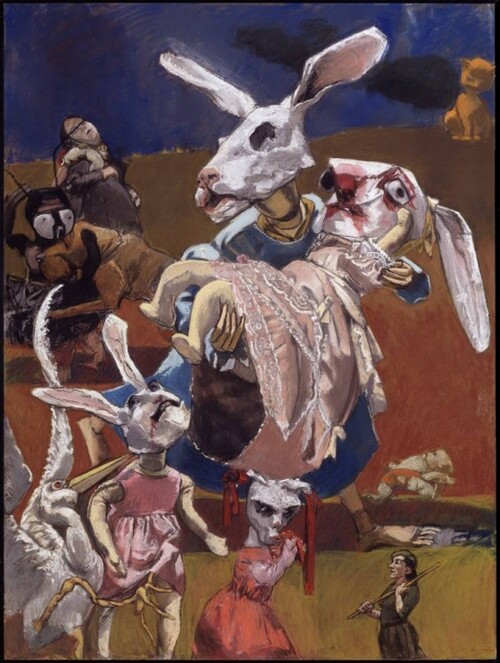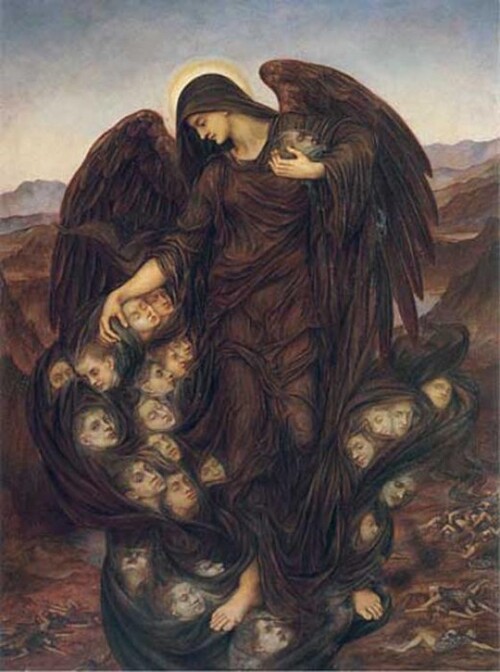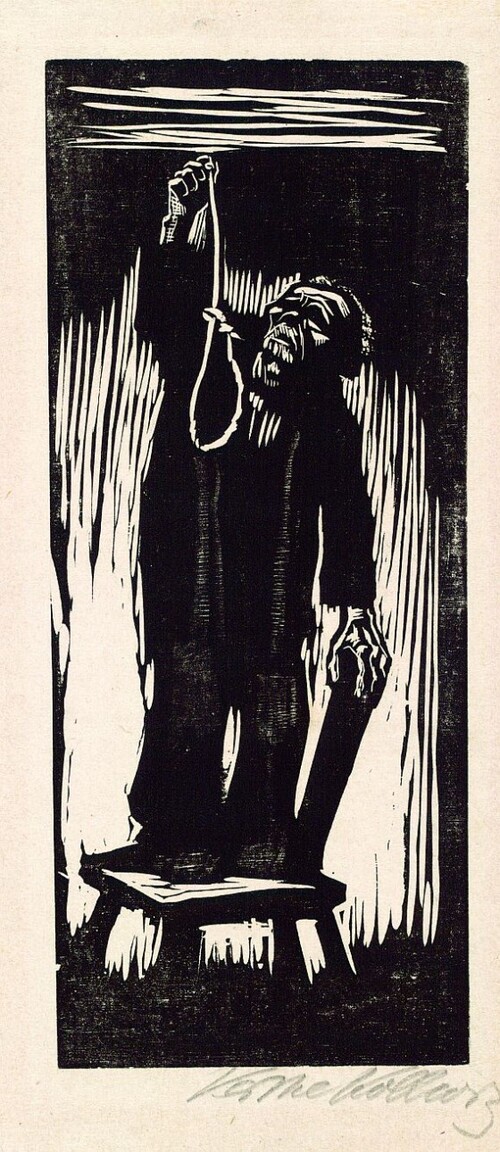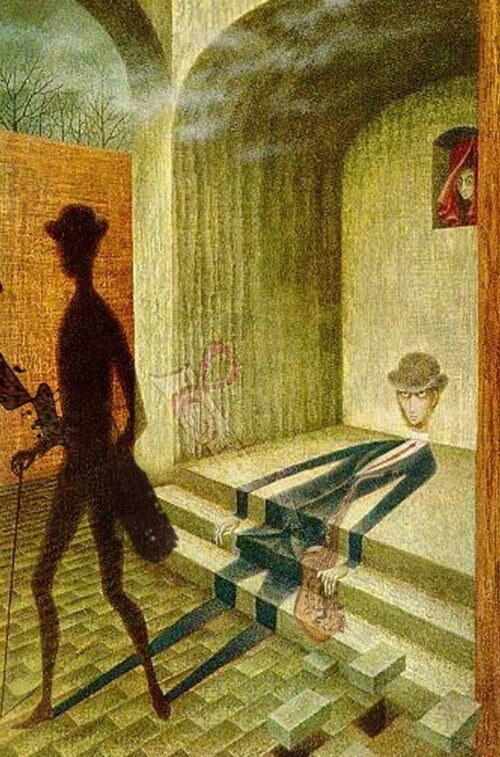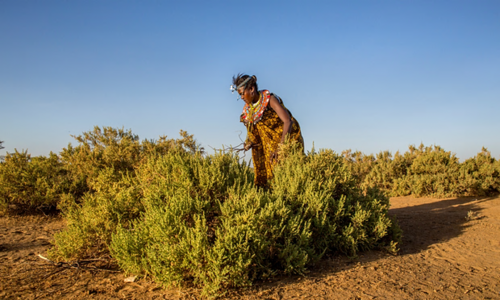-
13 Disturbing Works of Art by Female Artists. (By Asher Cantrell).
1. Artemesia Gentileschi - Judith and her Maidservant
The most remarked-upon absence from the previous list was Artemesia Gentileschi’s version of Judith Slaying Holofernes (as opposed to the Caravaggio, Judith Beheading Holofernes, that we featured). Feel free to click on each and decide which you prefer! In the meantime, this is an equally disturbing follow-up piece to Gentileschi’s depiction, showing Judith and her maid’s escape from Holofernes’ quarters with his severed, bleeding head in a basket.
2. Frida Kahlo - Without Hope.
One of the greatest painters of the 20th century, Mexico’s own Frida Kahlo is most notable for her self-portraits. This 1945 piece, Without Hope, is no exception. Frequently ill from surgeries and bouts of pain stemming from a bus accident in her teens, Kahlo was no stranger to hospitals. Microorganisms color her bedsheet, her world is featureless, simultaneous day and night, and her easel is overtaken by disturbing apparitions.
3. Lavinia Fontana - Portrait of Antonietta Gonzalez.
This particular painting is not so much creepy as it is bizarre. It seems almost like a strange joke played by artist Lavinia Fontana on an unsuspecting portrait model. It is a real portrait of a real girl, however. Antonietta Gonzalez was the daughter of Petrus Gonzales, and both (as well as Antonietta's siblings) suffered from hypertrichosis, commonly known as “werewolf syndrome.” Happily, instead of being ostracized, they were all welcomed into the court of King Henry II of France, highly educated, and well-respected.
4. Rosa Bonheur - The Duel.
Rosa Bonheur was one of the great painters of the French animalier style popular in the 19th century. It focused on doing one thing and doing it well: creating realistic paintings of animals. Bonheur, in particular, specialized in farm animals, and this piece shows the dark side of that world. Most interesting is its title, The Duel, evoking the traditional duels high-class males fought for women’s affections throughout history.
5. Paula Rego – War.
A far more modern piece than previous entries on the list, this painting was only created just under a decade ago, in 2003. Paula Rego, the artist, says that she was inspired by a photograph taken during the second Iraqi war. While a photograph of this sort might be a common sight in the news, replacing the victims with rabbits, a symbol of purity, gives the work a deeply disturbing angle.
6. Herrad of Landsberg - Hell, from Hortus deliciarum.
The oldest artist on this list, Herrad of Landsberg was a 12th century nun famous for her illuminated manuscript, Hortus deliciarum (Garden of Delights). Considered by many scholars to be the first encyclopedia written by a woman, it contains illustrated guides to instruct novice nuns about various teachings and philosophies that the convent followed. This particularly dark illustration is, obviously, from the entry on Hell.
7. Josefa de Obidos - The Sacrificial Lamb.
This painting, one of the still-life pieces for which Josefa de Obidos is most renowned, may not appear all that creepy upon initial inspection. Make sure you notice the lamb’s bound feet and despondent expression, however. Those details, combined with the title, The Sacrificial Lamb, tell a very disturbing story about this lamb (traditionally symbolic of innocence) and its future.
8. Giulia Lama - The Martyrdom of Saint Eurosia.
Historical accounts of beheadings, if you haven’t gathered, were very popular subjects for a great number of artists. Instead of Judith and Holofernes this time (though Giulia Lama did one of those as well, albeit much less gruesome than others), we have the decapitation of Saint Eurosia, patron saint of the city of Jaca, Spain. According to tradition, she was a princess forced into a marriage with a prince of the invading Moors. When she attempted to flee, the Moorish people hunted her down and executed her.
9. Camille Claudel – Clotho.
This sculpture, Clotho, is named after one of the three fates in Greek mythology. Clotho and her sisters, Lachesis and Atropos, determined the length and nature of a human’s life. Reportedly, this work was the result of Camille Claudel and her mentor, the famous sculptor Rodin, deciding to create works based on the forms of elderly women. Another version of the piece, made solely of the torso part of the overall work, is just as ghoulish on its own.
10. Evelyn De Morgan - The Field of the Slain.
Although this might look like something painted during the days of the Renaissance, it was actually created in 1916 as a response to the first World War. Its artist, Evelyn De Morgan, was a follower of the Pre-Raphaelite movement, which attempted to revive the style of the early Italian masters. A Spiritualist, and thus a firm believer in the afterlife, De Morgan made this representation of the Angel of Death collecting souls to take to the other side.
11. Kathe Kollwitz - The Last Thing.
This is another response to World War I, albeit from a far different perspective. After the end of the Great War, Germany experienced huge economic difficulties. Artist Kathe Kollwitz, a German native, saw the desperation and hopelessness prevalent in her fellow Germans. This woodcut, titled The Last Thing, is a grim depiction of what many elderly Germans saw as their only escape.
12. Maruja Mallo - Antro de Fosiles.
The third and final war-inspired piece on this list, Antro de Fosiles was actually considered lost for decades before it reappeared in 2010 and was purchased by the Guillermo de Osma Gallery in Madrid, Spain. Artist Maruja Mallo, a friend of Salvador Dali, was also horrified by war-torn Europe, but despite this painting’s appearance, it is not a statement about the use of atomic weapons. It was actually created in 1930, 15 years before their first use.
13. Remedios Varo – Fenomeno.
One of only a few female surrealist painters, Remedios Varo’s works are particularly dark and dreamlike. A penchant toward mysticism and fringe psychology in her personal life deeply influenced her works, which typically feature unusual geometric shapes, strange symbols, and beings that seem to be cobbled together from various objects and animals.
http://mentalfloss.com/article/12525/13-disturbing-works-art-female-artists
 votre commentaire
votre commentaire
-
Al-Can't see the irony… Bin Laden got down to Jewish, Zionist singer.
Among audio cassettes belonging to late al-Qaeda leader are the songs of Enrico Macias — an Algerian Jew who said last year he planned to move to Israel.
Osama bin Laden (photo credit: AP/file).
Playing in Osama bin Laden’s tape deck while he waged jihad against the US, the West and the Zionists were the French pop tunes of an Algerian Jewish singer who has talked about living in Israel.
A collection of 1,500 audio cassette tapes once belonging to al-Qaeda chiefs which were left behind when bin Laden fled Kandahar in 2001, during the US invasion, made their way to Afghan Media Project at Williams College in Massachusetts, the BBC reported Monday 17 of August 2015.
Among the sermons, recordings and songs sifted through by University of California Davis Arabic expert Flagg Miller was the music of Gaston Ghrenassia, better known as Enrico Macias, an Algerian Jew who made it big in France, and then across the globe, in the 1960s and 70s.
“These songs suggest that that someone, at some point in their life, was enjoying the songs of this Algerian Jew – and may have continued to enjoy them despite other struggles that clearly would have suggested doing so was heresy,” Miller told the BBC.
Enrico Macias and Yasmin Levy perform in Tel Aviv in 2011 (photo credit: Youtube screen capture).
“I think this collection of French songs reveal the extent to which Afghan-Arabs in Kandahar spoke many languages, and had many world experiences. Many had lived in the West for long periods and it can’t be said enough that they had led multiple lives,” Miller told the BBC.
Macias, née Gaston Ghrenassia, was born in the Algerian city of Constantine and moved to France in 1961, toward the end of the Algerian War of Independence. There he launched his music career with its distinct Oriental and Arabic sound. A staunch Israel supporter, Macias has visited the Jewish state on multiple occasions.
Last year, Enrico Macias announced that he would apply for Israeli citizenship and settle in the country permanently. “I feel free, I feel babayit sheli [at home],” Macias told Channel 2.
The 75-year-old explained that the increased threat of European anti-Semitism spurred his decision to relocate to Israel.
While bin Laden is better known for his violent struggle against Soviet Russia in Afghanistan and orchestrating deadly terrorist attacks against the US, one of his speeches recorded on a tape in the collection features him citing Mahatma Gandhi — an advocate of nonviolence.
“Consider the case of Great Britain, an empire so vast that some say the sun never set on it,” says Bin Laden. “Britain was forced to withdraw from one of its largest colonies when Gandhi the Hindu declared a boycott against their goods. We must do the same thing today with America.”
http://www.timesofisrael.com/bin-laden-got-down-to-jewish-singer/
 votre commentaire
votre commentaire
-
Only women are allowed to live in Umoja. Julie Bindel visits the Kenyan village that began as a refuge for survivors of sexual violence – and discovers its inhabitants are thriving in the single-sex community. (By Julie Bindel).
In the company of women: (centre) Judia, 19, came to the village of Umoja six years ago, having run away from home to avoid being sold into marriage. Umoja was founded in 1990 by 15 women who were raped by British soldiers. Photograph: Georgina Goodwin for the Observer.
Jane says she was raped by three men wearing Gurkha uniforms. She was herding her husband’s goats and sheep, and carrying firewood, when she was attacked. “I felt so ashamed and could not talk about it to other people. They did terrible things to me,” says Jane, her eyes alive with pain.
She is 38 but looks considerably older. She shows me a deep scar on her leg where she was cut by stones when she was pushed to the ground. In a quiet, hesitant voice she continues her story. “I eventually told my husband’s mother that I was sick, because I had to explain the injuries and my depression. I was given traditional medicine, but it did not help. When she told my husband [about the rape], he beat me with a cane. So I disappeared and came here with my children.”
Jane is a resident of Umoja, a village in the grasslands of Samburu, in northern Kenya, surrounded by a fence of thorns. I arrive in the village at the hottest time of the day, when the children are sleeping. Goats and chickens wander around, avoiding the bamboo mats on which women sit making jewellery to sell to tourists, their fingers working quickly as they talk and laugh with each other. There are clothes drying in the midday sun on top of the huts made from cow dung, bamboo and twigs. The silence is broken by birdsong, shrill, sudden and glorious. It is a typical Samburu village except for one thing: no men live here.
My arrival is greeted by singing and dancing from the women. They wear traditional Samburu dress of patterned skirts, brightly coloured shirts and a kanga (a colourful wrap) tied on their shoulders. Necklaces made of strings of vividly coloured beads form stunning circular patterns around their necks. The colourful clothing contrasts with the dry air and terrain, and the harsh sun that picks out the dust that fills the air.
‘I heard of a women’s community from gossip in my old village’: Seita Lengima, 68. Photograph: Georgina Goodwin for the Observer.
The village was founded in 1990 by a group of 15 women who were survivors of rape by local British soldiers. Umoja’s population has now expanded to include any women escaping child marriage, FGM (female genital mutilation), domestic violence and rape – all of which are cultural norms among the Samburu.
Rebecca Lolosoli is the founder of Umoja and the village matriarch. She was in hospital recovering from a beating by a group of men when she came up with the idea of a women-only community. The beating was an attempt to teach her a lesson for daring to speak to women in her village about their rights. The Samburu are closely related to the Maasai tribe, speaking a similar language. They usually live in groups of five to 10 families and are semi-nomadic pastoralists. Their culture is deeply patriarchal. At village meetings men sit in an inner circle to discuss important village issues, while the women sit on the outside, only occasionally allowed to express an opinion. Umoja’s first members all came from the isolated Samburu villages dotted across the Rift valley. Since then, women and girls who hear of the refuge come and learn how to trade, raise their children and live without fear of male violence and discrimination.
There are currently 47 women and 200 children in Umoja. Although the inhabitants live extremely frugally, these enterprising women and girls earn a regular income that provides food, clothing and shelter for all. Village leaders run a campsite, a kilometre away by the river, where groups of safari tourists stay. Many of these tourists, and others passing through nearby nature reserves, also visit Umoja. The women charge a modest entrance fee and hope that, once in the village, the visitors will buy jewellery made by the women in the craft centre.
Lolosoli is tall and powerfully built, her shaven head adorned with the traditional Samburu beaded ornaments. I am told by a number of the women in Umoja that Lolosoli has faced repeated threats and attacks from local men since setting up the village, but she is undeterred. I spoke to Lolosoli before travelling to Umoja – she was visiting her daughter in Germany during my visit – and she sounded proud of all that she and the other women had achieved in the 25 years since the village’s foundation.
Craft work: China Laprodati with her baby selling her jewellery. Photograph: Georgina Goodwin for the Observer.
One of the unique features of the Umoja community is that some of the more experienced residents train and educate women and girls from surrounding Samburu villages on issues such as early marriage and FGM. Ornate beaded jewellery is an important accoutrement of Samburu culture. Girls get their first necklaces from their father in a ceremony known as “beading”. The father chooses an older “warrior” male with which the daughter will enter into a temporary marriage at this time. Pregnancy is forbidden, but contraceptives are unavailable. If the child becomes pregnant, she is forced into an abortion, conducted by other women in the village.
“If a girl is married at an early age, that girl will not be a competent parent. Giving birth they face a lot of challenges: they rupture, they bleed, because they are young,” says Milka, head of the academy school built on the land owned by the Umoja women which is open to children from surrounding villages. “Even performing their duties, their chores, it is hard for them. They are thrown into taking care of animals.”
Under the “tree of speech”, where the women gather to make decisions, I speak to several residents keen to tell their stories.
“I have learned to do things here that women are normally forbidden to do,” says Nagusi, a middle-aged woman with five children. “I am allowed to make my own money, and when a tourist buys some of my beads I am so proud.”
Memusi is the official greeter. She walks towards me, the beads adorning her head and neck making soft clicking noises in the gentle breeze. She ran away from her husband after just one day of marriage, in 1998. “I was traded for cows by my father when I was 11 years old,” she tells me with the help of an interpreter. “My husband was 57.”
Child’s play: nursery school children. Some 200 children live in the village. Photograph: Georgina Goodwin for the Observer.
Judia, a talkative, confident 19-year-old, came to Umoja aged 13, having run away from home to avoid being sold into marriage. “Every day I wake and smile to myself because I am surrounded by help and support,” says Judia, her long plaits held back by colourful lengths of beads.
“Outside, women are being ruled by men so they can’t get any change,” says Seita Lengima, an elderly woman I meet in the communal shaded area in the village. “The women in Umoja have freedom.”
Curiously, for an all-woman village, there seems to be a lot of children around. How does this happen? “Ah,” laughs a young woman, “we still like men. They are not allowed here, but we want babies and women have to have children, even if you are unmarried.”
Lotukoi is the only man I meet in Umoja. He arrives in the village every day, before sunrise, to tend to the herds. “Children, firewood and cooking are women’s business, and men look after the animals,” he tells me when I ask why the women need him to help. “It’s funny because you don’t see men around here but you see small children, which means women go get men outside,” he says.
There is still suspicion of the village in the neighbourhood. In the next village, Samuel, the village elder, tells me that “the majority of men have three to four wives in this village”. He is chatting with a small group of men holding wooden spears and dressed in colourful tartan shukkas (wraps). They seem happy to talk about Umoja and become animated when I ask how the women manage to cope in such a male-dominated society. “This is a village of women who live alone, who are not married –some of them are rape victims, some are child marriage cases. They think they are living without men, but that is not possible.
“Many of them end up with babies,” continues Samuel, tapping his spear to emphasis his point, “because they meet men in the towns and get seduced by them, and men come here in the nights and go into their huts. Nobody else sees them.” The men all laugh.
‘Every day I wake and smile to myself’: Norkorchom from Turkana. Photograph: Georgina Goodwin for the Observer.
One young woman in Umoja tells me she has five children, all with different fathers. “It is not good to be unmarried and have children in our culture,” she tells me, washing baby clothes in a blue plastic bucket, using some of the precious water she collected early that morning from the nearby river. “But it is worse not to have any. Without children we are nothing.”
As the community of Umoja has grown, the memories of one of the main causes of it – the rape they were subjected to by British solders and Gurkhas – do not fade. “Once a woman is raped, they are not clean any more in Islam and Qur’an culture. It is not fair, because it happens by accident. The husband could have taken them for an HIV test so that they can continue with life, take care for their children and feed them,” says Sammy Kania, 33.
Back in Umoja I am invited by Seita into her hut, pungent with woodsmoke. It is bare inside except for a mat on which she sleeps, her makeshift fire and a paper bag full of dried black beans which she will cook at midday for the communal meal when the children break from school.
I ask how Seita knew about Umoja. “I heard of a women’s community from gossip in my old village,” she tells me and says she was happy from the first moment she arrived. “I was given a goat. I was given water. I started to feel safe and secure.”
Seita takes care of her granddaughter, dropping her at school each day before going to collect water and firewood. The rest of her day is taken up with making jewellery. She tells me she was raped by British soldiers. “I came because I was left unmarried. After what the British did to me, I would never be able to marry.”
I ask Seita her age, and she tells me she does not know. Passing me her ID card, Seita tells me her birthdate is apparently on it. Like many older Samburu women, Seita can neither read nor write. Her birthdate on the card is 1928.
I join a number of the women as they gather under the bamboo shade that serves as a communal space. When I arrived at the village, I asked if any of the women would be prepared to talk to me about their experiences of sexual violence at the hands of the military. “They put their pricks in you, didn’t they?” jokes Memusi. The women, despite their horrendous experiences, are able to laugh.
Ntipaiyo, stooped from age and hard work, her ribs visible through her colourful clothes, has been at the village for 15 years. “I came here because of problems with my husband,” she tells me. “The British army got me when I was collecting firewood. There were three of them. They pushed me to the ground. Since that day, I have always felt pain in my chest whenever I remember.”
In 2003, a group of women from Umoja met with solicitors from Leigh Day, a UK-based practice that held a monthly surgery in nearby Archers Post to work with locals who had been injured by bombs left behind by the British army.
The women disclosed allegations of rape spanning 30 years. Most women reported cases of gang rape by soldiers, who attacked the women when they were out gathering firewood or fetching clean water.
Up in smoke: Gabriella, 24, gathering firewood. Photograph: Georgina Goodwin for the Observer.
Martyn Day, a partner at Leigh Day, was one of the lawyers approached by the women. Day and his team gathered a number of original documents, such as police and medical reports. There was a number of mixed-race children, yet relationships between Samburu and white people were unheard of.
Day reported his findings to the Royal Military Police. “However [the RMP] came to the view that every single one of these entries had been forged, even in the strongest cases identified,” says Day. “They made no DNA checks on the mixed-race children because of the estimated 65,000 to 100,000 soldiers who would have been in Kenya during the 30-year period.”
When the RMP had concluded its investigation, Day requested the documentation back but was told that it had all gone missing. The paperwork has never been found.
The case is not closed but, says Day, it would be extremely difficult to relaunch without the documentation. “We wanted to argue for compensation for the women and girls who had suffered at the hands of the soldiers,” says Day. “Their lives were, quite literally, ruined.”
Jane, who came to Umoja to escape her abusive husband after being raped by the Gurkhas, has no plans to remarry, but wishes to stay in the village so that she can be supported and her children can go to school. “I want my children to be free to marry who they choose for themselves,” she says.
Many of the women tell me they cannot imagine living with a man again after they have been living in Umoja. Towards the end of my visit I meet Mary, 34, who tells me she was sold to a man of 80 for a herd of cows when she was 16 years old. “I don’t want to ever leave this supportive community of women,” she says.
Mary shows me a handful of dried beans that she will be cooking soon for dinner. “We don’t have much, but in Umoja I have everything I need.”
 votre commentaire
votre commentaire
-




